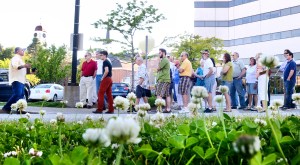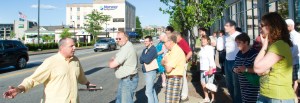AUBURN — Traffic, and its excessive noise and speed, was the principal topic of a downtown walking tour late Thursday afternoon.
Alan S. Manoian, an economic development specialist for the city, led about three dozen residents on a show-and-tell expedition capped with a “Civic Design” session at Auburn Hall.
Manoian’s tour began from the city building’s front steps at 5:30 p.m., where he emphasized unfavorable pedestrian aspects at the intersections of Court and Turner streets and Court and Main streets. He stood close to the sidewalk’s edge and demonstrated the “pressure waves” from passing trucks.
He led the group along the Turner Street sidewalk, pointing out the location of old buildings, including a large bank and the former Post Office built in the late 1800s, that were demolished for urban renewal in the early 1970s.
He took the group around the corner of Turner and Hampshire streets, speculating that the area might have the appropriate form and function to be considered a central square.
The walk continued around Great Falls Plaza, where Manoian noted pros and cons of the various buildings, including the day-only use of the multi-story building “just waiting for the cars to come back every day,” and the potential for showcasing the Great Falls view, which he described as L-A’s crown jewel.
At the intersection of Main and Court streets, the walk light changed before most of the walkers in the large group had crossed.
“We got this all wrong,” Manoian said of the city’s traffic control as cars paused before making their turns from Main to Court.
As the walk continued down Main Street, Manoian’s characterization of the area changed. He had high praise for the redevelopment of several older buildings and the use of projecting signs, which he favored over flat signs, on buildings.
“This part of the street is a whole different form,” Manoian said. “It’s a textbook rescue” of a pedestrian-friendly municipal area, he said.
The walking tour ended back at Auburn Hall where the group assembled in the Community Room. Manoian continued his presentation, titled “Downtown Auburn: Form-First,“ with a video slide show that explained how he believes a form-based code can return Auburn to a more humanized, sensitized and people-oriented city. Such an approach would rely upon a simplified type of zoning code that would take into consideration things such as building height, siting, development and use.
In a review of Auburn’s downtown, Manoian said, “There’s nothing to look at. That’s why people rip through Court Street.” He called for more attention to on-street parking and sidewalk frontage of businesses.
Manoian’s presentation, including the walking tour and the slide show, ran about two hours. The public participants were attentive but quiet. There were few questions, and Manoian concluded the session by inviting the attendees to take markers at four tables with large city maps and indicate where they believed downtown centers should evolve.
Manoian said the next session on form-based code in Auburn would take place “in two or three weeks.”
He told the group, “You’re designing this code over the next six to nine months.”


Comments are no longer available on this story